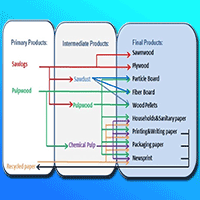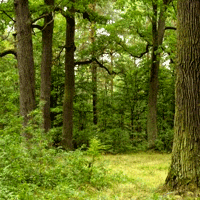
Integrating forest-based industry and forest resource modeling
Ragnar Jonsson , Francesca Rinaldi, Minna Räty, Ola Sallnäs
iForest - Biogeosciences and Forestry, Volume 9, Issue 5, Pages 743-750 (2016)
doi: https://doi.org/10.3832/ifor1961-009
Published: Aug 12, 2016 - Copyright © 2016 SISEF
Research Articles
Abstract
This paper introduces a modeling approach for the assessment of policy options within the forest-based bioeconomy. The feedback between the forestry dynamics model and the economic model of the global forest-based sector of the proposed framework is essential, not only for response analysis as to the development of forest resources and for a correct assessment of future harvesting potentials, but also for the assessment of the impact of different management regimes on wood-based product markets. Test runs of the modeling framework on a Swedish case highlight the necessity of considering timber assortments for a comprehensive integration of forest resources and wood-based commodity market dynamics. Hence, the composition of harvest demand in terms of timber assortment affects the allocation of harvesting activities and, consequently, the development of forest resources (and thus future harvest potentials), as well as the production, trade and consumption of wood-based products.
Keywords
Policy, Bioeconomy, Wood-based Products, Market, Forest Resources
Authors’ Info
Authors’ address
Francesca Rinaldi
Minna Räty
Ola Sallnäs
European Commission, Joint Research Centre (JRC), Institute for Environment and Sustainability (IES), Forest Resources and Climate Unit, v. E. Fermi 2749, I-21027 Ispra (Italy)
Corresponding author
Paper Info
Citation
Jonsson R, Rinaldi F, Räty M, Sallnäs O (2016). Integrating forest-based industry and forest resource modeling. iForest 9: 743-750. - doi: 10.3832/ifor1961-009
Academic Editor
Luca Salvati
Paper history
Received: Dec 21, 2015
Accepted: Jul 01, 2016
First online: Aug 12, 2016
Publication Date: Oct 13, 2016
Publication Time: 1.40 months
Copyright Information
© SISEF - The Italian Society of Silviculture and Forest Ecology 2016
Open Access
This article is distributed under the terms of the Creative Commons Attribution-Non Commercial 4.0 International (https://creativecommons.org/licenses/by-nc/4.0/), which permits unrestricted use, distribution, and reproduction in any medium, provided you give appropriate credit to the original author(s) and the source, provide a link to the Creative Commons license, and indicate if changes were made.
Web Metrics
Breakdown by View Type
Article Usage
Total Article Views: 49824
(from publication date up to now)
Breakdown by View Type
HTML Page Views: 41273
Abstract Page Views: 3283
PDF Downloads: 3884
Citation/Reference Downloads: 72
XML Downloads: 1312
Web Metrics
Days since publication: 3427
Overall contacts: 49824
Avg. contacts per week: 101.77
Citation Metrics
Article Citations
Article citations are based on data periodically collected from the Clarivate Web of Science web site
(last update: Mar 2025)
Total number of cites (since 2016): 11
Average cites per year: 1.10
Publication Metrics
by Dimensions ©
Articles citing this article
List of the papers citing this article based on CrossRef Cited-by.
References
A new EU forest strategy for forests and the forest-based sector. Communication from the Commission to the European parliament, the Council, the European Economic and Social Committee and the Committee of the Regions. European Commission, Brussels, Belgium, pp. 17.
Gscholar
Forest product conversion factors for the UNECE region. Geneva Timber and Forest Discussion Paper 49, UNECE/FAO, Geneva, Switzerland, pp. 34.
Gscholar
Econometric modeling and projections of wood products demand, supply and trade in Europe; Geneva Timber and Forest Discussion Paper 59, UNECE/FAO, Geneva, Switzerland, pp. 192.
Gscholar
Environmentally compatible bio-energy potential from European forests. European Environment Agency, Copenhagen, Denmark, pp. 53.
Gscholar
The European forestry dynamics model (EFDM). JRC Scientific and Policy Reports, Publications Office of the European Union, Luxembourg, pp. 16.
Gscholar
Deliverable D2.3.7. Project EFORWOOD “Modeling the impacts of forest management alternatives on recreational values in Europe”, Forest Research, Roslin, UK, pp. 19.
Online | Gscholar
European forest sector outlook study II. United Nations, FAO/UNECE Agriculture and Timber Division, Timber Branch, Geneva, Switzerland, pp. 107.
Gscholar

















